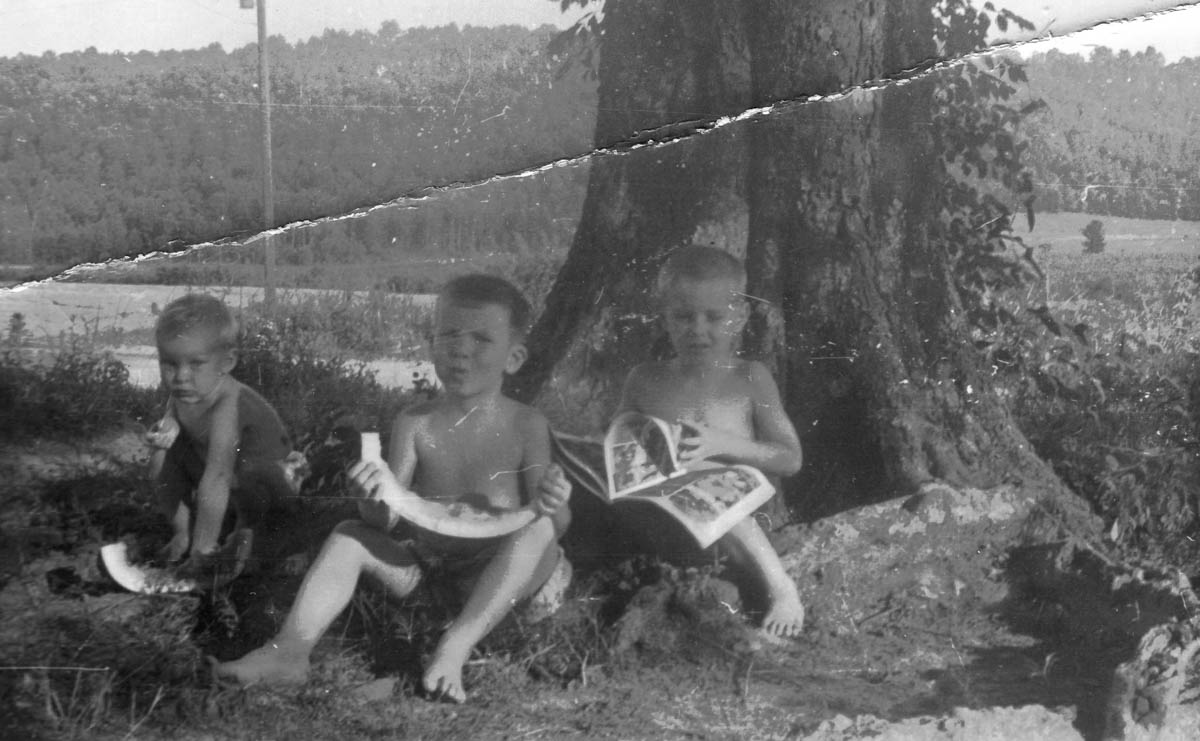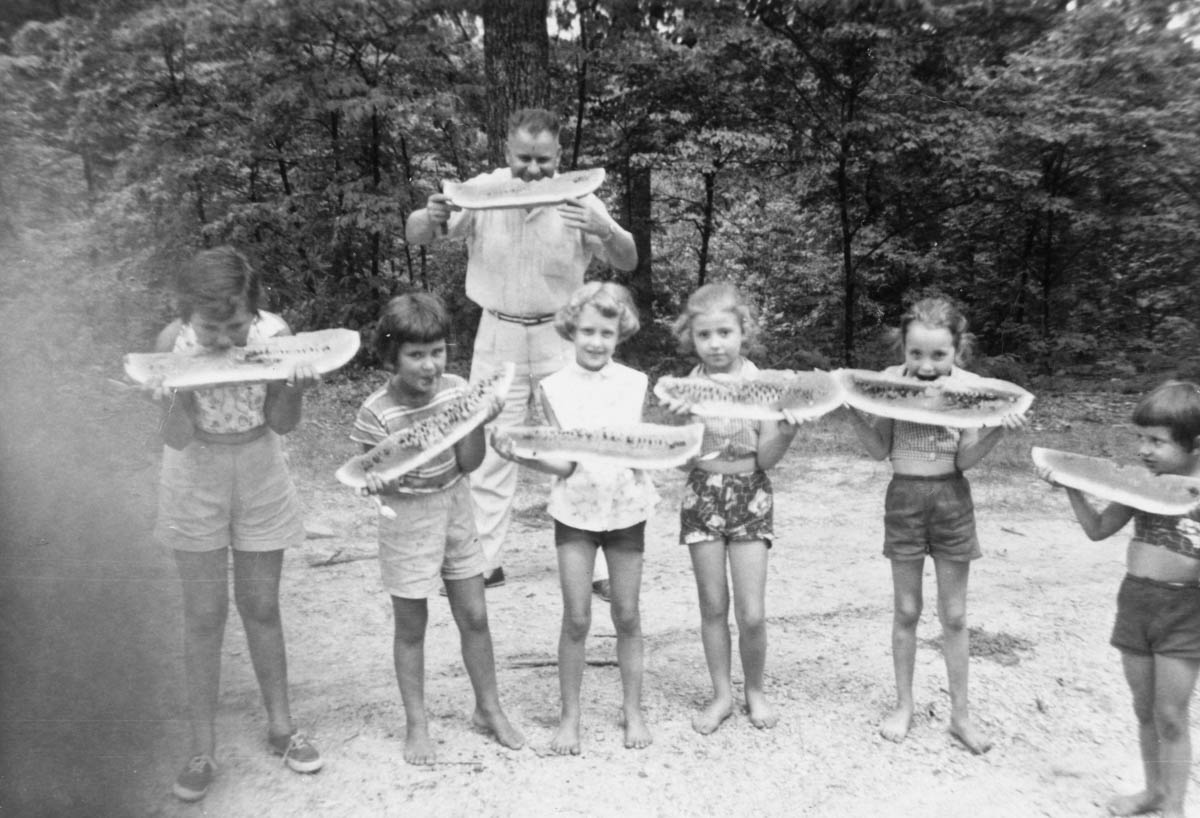Childhood Melon Memories: Happy National Watermelon Day

Fresh fruits and vegetables were a part of everyday life growing up on the farm. The best meals were always those prepared straight from the garden. While my parents were not farmers by trade–they were school teachers–they always had a garden of some sort. My grandparents, however, farmed on a larger scale. One of the crops I remember most clearly and associate very closely with my grandfather Earl Jordan is watermelon. Earl would load up the back of his truck (which I proudly drove in my teenage years after he had died), sit by the road, tailgate down, and sell the delicious fruit to passersby. Of course, there was plenty to go around for the family, too. We would all gather around the table at Grannie’s house, ready for a messy feast of some good ol’ watermelon. Careful not to swallow any seeds!
Watermelon wasn’t only a summer tradition for me growing up but for my parents, too. Dad recalls eating a lot of watermelon at his Grandpa Holcomb’s house. “He grew them, and I think he may have also bought some,” Dad reminisced about the old days. “Grandmother would keep some in the refrigerator and slice it off and eat it cold, but we also ate them fresh from the field.”
Photographic evidence would suggest, however, that my father was more interested in comic books than watermelon. Here he is in 1952, comic book in hand (wish I could make out what he was reading), with his brother Eric (far left) and an unidentified friend.

Mom’s childhood memories are more vivid. She recalls her father grew watermelons as big as 40 or 50 pounds! Certainly not a record holder, but pretty hefty nonetheless. “It was a treat to have watermelon,” she tells me. I asked her to share some of her memories with me:
“We always kept a salt shaker at hand and sprinkled it as we ate further down to the rind. My daddy would have a truckload of watermelons and take them to town to sell. Big ones were $5 or more. He sometimes sat at the corner on the weekends, and people stopped by because he was known for his delicious watermelons. He also kept some in the yard on a wagon with straw in it and sold to people from it. He grew watermelons up until the last summer of his life, but Mike would have to help him gather them if they were heavy. Daddy would do the thumping to determine if they were ripe. Mike wasn’t as good at that.
“Mother would save some of the rinds to make watermelon rind preserves which she saved to use in a jam cake for Christmas. Some of the rinds we fed to the pigs.
“My Gramp Pope liked watermelon, but rather than salt his, he put sugar on it. Watermelon suppers were often had at get togethers in the summertime.”
Mom even remembers a specific time she enjoyed watermelon. In the summer of 1956, Pastor John Blevins (of East Armuchee Baptist Church) took his daughters and their friends from church to Chickamauga Battlefield. They enjoyed a delicious watermelon feast that day. Here you can see Mr. Blevins and the girls, left to right: Valeire Blevins, unknown Blevins, Delores Richardson, Rhonda Jordan (mom), June Pope, Rose Blevins.

Even today, watermelon continues to be a part of mom and dads lives:
“We have some watermelons in our garden occasionally but they are not as good as the Nancy Hance [variety that daddy grew]. It is hard to find those seed any more. You can save them from your melon to plant the next season. My daddy must have know what he was doing when raising watermelons!”
I wonder if radical gardener Sylvia Davatz has any Nancy Hance seeds tucked away in her closet? I can’t even find a reference to this seed type online. Sadly, I don’t have any photographs of the watermelons Earl grew, much less the seeds. The photo at the top of the page is one I took–not a Nancy Hance variety–on a road trip in North Carolina in 2004. It’s my tribute to Papa Jordan.
Soon after I asked Mom about her “watermelon memories” earlier this year, she saw one of her Clement family cousins. Mom asked Cousin Billy about his watermelon memories. He recalled that his grandfather, William Madison Clement (my great grand uncle), used to raise watermelons just like my grandfather Earl. He told the story of how they would harvest them but not pick the biggest watermelon of the bunch. After all the melons had been selected and carefully placed in their nests of straw on the wagon, Billy (William Madison) would return for the largest of them all. As he headed back to the wagon, he would release it and–boom!–drop it to the ground, the red flesh exploding. No doubt baking in the summer heat by now, they would all descend upon the sweet fruit and have a feast right there in the field.
These sorts of pastoral anecdotes are the kind of stories my history is full of–both my own time growing up on the farm in East Armuchee, as well as my parents and their parents before them. Country life may seem unremarkable to most. And while it is far from my world now–I sit in a skyscraper in New York’s Manhattan as I write this–the simple taste of watermelon helps me travel back in time to that place where all is quiet and simple.
In my mind’s eye, I see Earl sitting on the tailgate of his truck. I see myself driving that same truck and connect a line back to him. I tip my hat towards the sun and follow him into the field, where we share a delectable slice of watermelon together.
Read more about Earl Jordan and my memories growing up on a farm in East Armuchee in the Jordan’s Journey book.
Take a trip into the past
Thanks for visiting the Jordan's Journey blog archive. These posts have been made available here for continued reference and research purposes.
The original book is available to order from our shop or your favorite bookseller.
For questions or other inquiries: get in touch.


The girl to the right of me is June Pope, daughter of my Uncle Orville. That photo was made in the park at Chickamauga Battlefield near the tower where Pops in the Park used to be held. We once took you there on July 4. Chattanooga Symphony Orchestra played patriotic songs. We parked in a field. Your father and I went back another time after that in our modern covered wagon and sat beside it. We were much further from the tower that time, but the music and fireworks were still just as wonderful. Since then, Pops in the Park has been moved to Coolidge Park in downtown Chattanooga across the river from the Aquarium. Parking is more difficult there so I have not been to it since it changed locations. In the era of this photo, preachers and their families were involved with every family. Someone would always have them for Sunday dinner, but on this occasion the pastor treated June, Delores and I to a watermelon picnic along with his three daughters.
I didn’t know it was taken at Wilder Tower–that’s a nice detail! Did you climb to the top of the tower that day? What else did you do that day at the battlefield?
Thanks for the update about June–I’ve corrected that now.
Yes, I do remember going up the tower.
By the way, some wild animal ate every single watermelon we grew this year. No watermelon to enjoy this watermelon day!